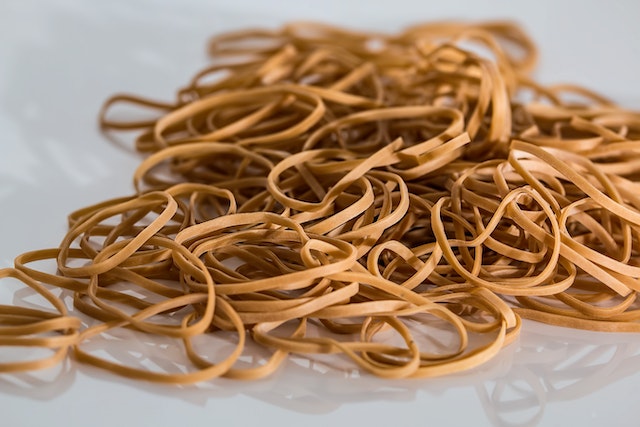
#433 Why does an elastic band stretch?
Why does an elastic band stretch? Because it is made of long chains of polymers that would rather be tangled together than straight.
Rubber is famous for its ability to expand and return to its original size without any damage. There are natural rubbers and synthetic rubbers. The English word “rubber” was first used in 1788. It was originally called “caoutchouc”, which is the French word for rubber and itself comes from the Spanish word “cauchuc”, which came from the Quechua word “kauchuk”. The Quechua people lived in South America and there were many groups of them. The Inca were Quechua people. The Spanish discovered rubber there and kept the name for it. The English word came because people used rubber to rub out pencil mistakes, hence “rubber”.
Natural rubber was first used in South America by the indigenous people. They extracted it from the hevea tree. This is not the only rubber tree, but it grew in abundance in South America. They used the rubber trees to make balls and to waterproof things. The Spanish saw what they did with it and introduced it to the world.
There are over 2,500 types of trees that produce rubber. Rubber trees produce latex to protect themselves if they are injured. In the same way as a self-sealing tire, if the tree is cut or injured, the latex will flow into the cut and seal it up, protecting the tree from insects. The latex is removed from the tree in the same way that maple syrup is. A hole is made in the bark and a tap is inserted. The latex oozes out of the tree and is collected in a bucket. This latex is not yet ready to use. Ammonia is added to stop the sap from solidifying and then acid is added to separate out the rubber. This is called coagulation and takes about 12 hours. The mixture is then rolled to remove excess water and dried.
Synthetic rubber was first made in 1909. It is made from petroleum. There was a sudden jump in the demand for rubber with the invention of the pneumatic tire for the bicycle in the 1890s, and synthetic rubber was created to fill that need. Like many things, the research money available in World War 2 improved and increased the synthetic rubber available. Today, about half of the rubber we use is synthetic and half natural.
So, why does an elastic band stretch? The molecules inside rubber are connected together in very long chains, called polymers. Thousands of atoms can be joined together in one polymer. They are joined by chemical bonds and these bonds are not rigid, so the atoms can move in any direction. Because of this, the polymers are not straight; they bend randomly and form a twisted pattern. Rubber is made up of a huge number of polymers like this and they are all twisted and knotted around each other. When a force is applied to stretch the elastic band, the polymers all straighten out, and when the force is released, they return to their twisted, knotted form. The polymers don’t stretch, they are just longer in the same direction when they are pulled, making the elastic band longer.
The reason this happens is because of entropy. Entropy is the second law of thermodynamics. Everything in the universe proceeds towards entropy. Entropy simply means that things that are ordered will become disordered. This is because, still talking about rubber, the number of possible ways that polymers can align to be straight is far fewer than the number of ways they can align to be tangled up.
When you pull the ends of the elastic band, you are applying energy. You have to apply enough energy to overcome the entropic force that is holding all of the polymers in a twisted mesh. This energy ends up as heat, which is why the elastic band, or any stretched rubber, gets warm. This heat energy makes the molecules in the polymers move faster in random directions, which makes it more difficult for them to stay aligned. When you let go of the elastic band, the molecules are jiggling around randomly and slowly become entangled again. They have to use energy to move, and that comes from the thermal energy that you supplied when you pulled the band in the first place. As the polymers retangle, this heat energy is lost to the air and the elastic band cools down again.
As natural elastic ages, the polymers start to oxidize and the bonds between the molecules start to break down. After enough molecule bonds have broken, the elastic band is no longer elastic. Sunlight can do the same thing.
So, elastic bands stretch because the polymers inside them would rather be in a state of entropy than a state of order.
Sources
https://en.wikipedia.org/wiki/Quechua_people
https://www.coruba.co.uk/blog/how-is-rubber-made/
https://en.wikipedia.org/wiki/Synthetic_rubber
https://en.wikipedia.org/wiki/Natural_rubber
https://www.etymonline.com/word/rubber
https://en.wikipedia.org/wiki/Rubber_elasticity
https://en.wikipedia.org/wiki/Elastomer
https://pslc.ws/macrog/exp/rubber/sepisode/ent.htm
https://science.jrank.org/pages/2290/Elasticity-Elastomers.html
